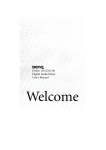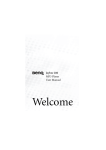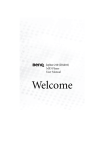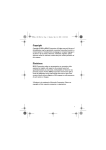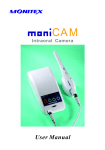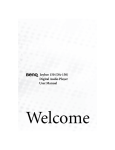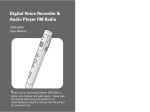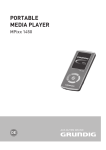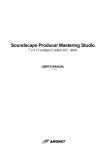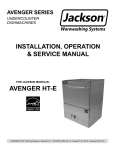Download Benq 256MB SilverJoybee 180
Transcript
Joybee 180 MP3 Player User’s Manual Welcome Copyright All rights reserved. No part of this publication may be reproduced, transmitted, recorded, stored in a retrieval system, or translated into any language or computer language, in any form or by any means, electronic, mechanical, recording, photocopying, or otherwise, without the prior permission of BenQ Corporation. Disclaimer BenQ Corporation shall make no warranty or representation, either expressed or implied, with respect to the quality, accuracy or fitness for any particular purpose of this document. The information in this document is subject to change without notice. The content of this manual has been checked and proofread prior to publication. *Windows is the registered trademark of Microsoft Corporation. All trademarks or product names appearing in this manual are registered property of their respective owners. Cautions • • • • • • • This MP3 player is a delicate electronic device - DO NOT OPEN IT. When formatting memory only use the FAT16 format. Do not attempt to disassemble or modify any part of the device. Avoid shock or impact to the device. Keep the device away from water. Keep the device away from extreme temperatures, humidity, dust or direct sunlight. Do not clean the device with chemical solvents. Clean the device with a cloth dampened with water. • • • Use only the adapter and accessories approved by the manufacturer. Warranty is voided if other adapters or accessories are used, which may be dangerous. Avoid listening at high volume, which may damage your ears and cause loss of hearing. BenQ Corporation assumes no responsibility for the loss of data due to damage to the device, repair of the device and/or battery replacement. Users are advised to back up all data on other storage devices. Use of the device not in accordance with the instructions will void the warranty. Memo Table of Contents Introducing the BenQ Joybee 180 MP3 Player......... 1 Introduction ................................................................................. 1 Package contents .......................................................................... 2 System requirements .................................................................... 3 Touring the BenQ Joybee 180 MP3 Player ................................. 4 OLED display ............................................................................ 8 Getting Started ........................................................... 10 Attaching the strap ....................................................................... 10 Attaching the carry strap.............................................................. 12 Changing the cover....................................................................... 12 Charging the battery..................................................................... 14 Charging using the AC power adapter .................................... 15 Charging through the PC ......................................................... 15 Connecting the Joybee 180 to a PC ............................................. 16 Disconnecting the Joybee 180 from a PC.................................... 17 Installing the software .................................................................. 19 Installing the USB driver.............................................................. 21 Installing in Windows ME/Windows 2000/Windows XP...... 21 Installing in Windows 98SE ..................................................... 21 Using the BenQ Joybee 180 MP3 Player ................... 22 Turning the Joybee 180 on and off.............................................. 22 Transferring data to the Joybee 180 ............................................ 23 Transferring data with Windows File Manager ...................... 23 Transferring files with QMusic ................................................ 23 Playing MP3/WMA/WAV music files......................................... 24 Repeat play ................................................................................ 25 Selecting an EQ mode............................................................... 26 Listening to FM radio................................................................... 27 Saving preset channels in memory .......................................... 28 1 Recording FM radio ................................................................. 28 Using the recorder function ........................................................ 29 Playing back recorded voice/FM files ......................................... 30 System setup ................................................................................. 31 Deleting files from the Joybee 180........................................... 31 Setting the playlist .................................................................... 32 Setting the recording quality.................................................... 33 Setting the power save interval ................................................ 33 Setting the date and time ......................................................... 33 Setting the language ................................................................. 35 Viewing system information.................................................... 36 Using QMusic .............................................................37 Overview of QMusic .................................................................... 38 Adding music to the Joybee 180 using QMusic ......................... 42 Adding music from an audio CD to Joybee 180..................... 43 Adding files from a PC to Joybee 180...................................... 47 Updating Joybee 180 automatically with QMusic ..................... 50 Deleting files using QMusic......................................................... 54 Troubleshooting .........................................................56 Service Information....................................................57 2 Introducing the BenQ Joybee 180 MP3 Player Introduction Thank you for purchasing the BenQ Joybee 180 MP3 Player! The BenQ Joybee 180 MP3 Player offers high quality audio playback and voice recording functions at low power consumption. The Joybee 180 supports MP3, WMA, and WAV music formats for your listening pleasure. Moreover, the seven built-in EQ modes of the Joybee 180 allow you to enjoy music at the best sound quality. In addition to being a MP3 player, the Joybee 180 also functions as a FM radio, an audio recorder, and a FM transmitter for music share. The FM radio function enables you to preset up to 16 radio stations for quick and easy listening. The recording function enables you to record your voice from the built-in microphone, from the radio receiver or from the MP3 player. The FM transmitter allows you to broadcast your music with another device equipped with a FM transceiver. Joybee 180 not only enriches your musical life but also allows you to carry your data everywhere. Its convenient driver-free plug and play function allows you to use it as a USB flash disk on Windows 98SE/2000/ME/XP. The Joybee 180 comes equipped with a software suite for additional convenience. The QMusic software enables you to convert and transfer music from your PC or audio CDs to the Joybee 180. 1 Package contents Check the contents of your Joybee 180 MP3 Player package. Contact your dealer immediately if any accessories are missing or appear damaged. (1) (2) (3) (4) (5) 8 (6) (7) (8) (9) (1) BenQ Joybee 180 MP3 Player (2) Bonus changeable cover (3) USB cable (4) Earphones (5) Carry bag (6) Carry strap (7) CD-ROM(emanual/ QMusic/ Driver etc.) (8) Quick start guide (9) Warranty card (10) Strap 2 (10) (1) (2) Optional Accessories (1) Wired remote+FM transmitter (for music share use) (2) AC adapter System requirements Your PC must comply with the following requirements in order to enable data transfer to your player: • • • • • • OS: Microsoft Windows 98SE/2000/ME/XP (QMusic supports Windows 2000/XP) CPU: Pentium 200 MHz or faster I/O port: USB (1.1 or higher) Device: CD-ROM Hard disk space: 40 MB (minimum) System memory: 32 MB (minimum) Please read this manual carefully to find detailed descriptions and instructions of every function of the Joybee 180 in order to use these convenient functions and enjoy high quality music with the Joybee 180. 3 Touring the BenQ Joybee 180 MP3 Player The following section describes the various components of the Joybee 180. Buttons and ports Top View (2) (1) Left View MIC Rear View (3) Right View MODE VOL A-B/ T (8) (9) (4) (6) (7) Front View (10) (11) (12) (5) 4 Item Description Function (1) Earphone and wired remote control jack Connects to earphones and wired remote control jack. (2) MIC High sensitivity built-in microphone for voice recording. (3) Power on/off button • Press once to turn on the Joybee 180. After the welcome note is displayed, Joybee 180 enters the last used mode automatically (default is MP3/WMA playback). If there are files on the Joybee 180, the titles of these files are displayed on the screen. • Press and hold for 2 seconds to turn the player off. (4) OLED display Displays player status and file information. See "OLED display" on page 8 for details. (5) USB port Connects the Joybee 180 to a PC or to the AC adapter for charging the built-in battery. (6) A-B repeat/ Lock) • Follow this procedure to repeat a desired section during audio playback. A-B/ T i. Press once to set point A. ii. Press again to set point B and the section from point A to B repeats continuously. iii. Press again to disable the repeat function. • Press and hold for 2 seconds to lock or unlock the keys. 5 Item Description Function (7) Volume control Press VOL – or VOL + to decrease or increase volume respectively. Press and hold VOL – or VOL + to decrease or increase volume continuously. VOL (8) Record (9) Mode Press to start recording. Press again to stop recording. MODE • Press to switch modes. • Press and hold for 2 seconds to display options for the current mode. • Press to cancel current setting and go back to the previous level in setup or playback mode. (10) Next/Fast Forward • Press once to skip to the next file in audio file playback mode. • Press and hold to scan forward an audio file in playback mode. • Press once to scroll down to the next item in menu mode. • Press and hold to scroll down continuously in menu mode. • Press once to skip to the next channel or frequency in FM radio mode. Press and hold down to increase frequency continuously. • Press and hold to auto-scan the frequencies in forward direction in FM radio mode. • Press to skip to the next item in setup mode. 6 Item Description (11) Play/Pause/ Stop/Enter Function • Press once to play an audio file in playback mode. Press once to pause playback and press again to continue playing in playback mode. • Press and hold for 2 seconds to stop playing or recording and switch to file list layout. • Press to confirm a selection of a menu item in setup mode. (12) Previous/Fast Rewind • Press once to restart the current playing song, and press again to skip to the previous file in audio file playback mode. • Press and hold to rewind an audio file in playback mode. • Press once to scroll up to the previous item in menu mode. • Press and hold to scroll up continuously in menu mode. • Press once to skip to the previous channel or frequency in FM radio mode. Press and hold down to decrease frequency continuously. • Press and hold to auto-scan the frequencies in reverse direction in FM radio mode. • Press to skip to the previous item in setup mode. 7 OLED display The OLED screen displays information about the player mode and file information. The following table shows the icons displayed on the screen and their meanings. Icon Description Indicates playback of an audio file. Indicates playback has been paused. Indicates audio file being scanned in forward direction (Forward). Indicates audio file is being scanned in reverse direction (Rewind). Indicates FM signal strength. Indicates the recording time left or the real time clock in power save mode. Indicates recording in progress. Indicates that recording has been paused. Indicates single track repeat mode. R Indicates random mode. RR Indicates random repeat mode. OFF Indicates repeat mode is disabled. Indicates A-B repeat mode. Indicates repeat mode for all files. Indicates MP3/WMA mode. Indicates voice recording mode. Indicates audio recording mode. Indicates FM mode. Indicates setup mode. Indicates battery status. Also indicates if the player is connected to a PC and is charging. 8 Icon Description Indicates keys are locked. USB / Indicates player is connected to a PC with the USB port and the battery is charging. Indicates player is connected to a PC with the USB port and data is being transmitted. Every Heart Displays file information and player status. In MP3/WMA, voice playback, and FM file playback mode, and the file title/artist information is displayed. In FM mode, the current channel frequency is shown. 9 Getting Started Attaching the strap The Joybee 180 has a stylish design, enabling you to connect it to your belt using the strap or carry it around using the carry strap. To attach the strap, do the following: 1. Turn the ring around the OLED screen in the clockwise direction to start removing it. 2. Remove the ring by lifting it and place the circular ring of the strap around the OLED screen as shown. Note: Please put away this ring carefully either you change the case or remove the strap. 10 3. Place the ring on top of the shoulder strap ring, around the OLED screen. 4. Turn the ring in anti-clockwise direction and fix it in place. 11 5. Flip the player over and insert the other end of the shoulder strap into the slot on the back panel. Attaching the carry strap To attach the carry strap, do the following: 1. Remove the strap if it is attached. 2. Insert the carry strap into the slot on the back panel of the Joybee 180. Changing the cover The Joybee 180 also has a changeable cover for additional variety. To change the cover, do the following: 1. 12 Remove the ring around the OLED screen by turning it in the clockwise direction. 2. Remove the ring by lifting it. Remove the strap by sliding it out if it is attached. 3. Remove the outer cover of the Joybee 180 by unlocking the snaps on its outer edges. 4. Snap the desired cover on the Joybee 180 and turn the ring in counterclockwise direction to complete replacement. 13 Charging the battery The Joybee 180 can be charged using the AC power adapter (optional accessory) as well as from the PC. Charging is done through the USB port as follows: • Exact charging time differs according to battery status. • Chargers for use in some areas may not have an indicator. Check the battery charge status using the indication on the OLED display (see "OLED display" on page 8). • The life of the battery depends on the frequency of charge, and more frequently the battery is recharged, the shorter the replay time of the device. This is a normal phenomenon and not a manufacturing defect of the battery. • When the batteries are fully charged, Joybee 180 offers about 15 hours of continuous playback time for MP3 music. However, the exact replay time is subject to the condition of the battery, the operating frequency and the format of the files being played. 14 Charging using the AC power adapter Connect the AC power adapter to the USB socket of the Joybee 180 using the USB cable provided. Connect the adapter to a wall outlet. The battery starts charging. The battery is fully charged in about 4.5 hours. • If the Joybee 180 is off when charging begins, it turns on automatically and enters the mode of latest use. Charging begins as indicated by an animated battery icon on the OLED display. • AC adapter LED indicator turns green when recharge is completed. • The player turns off automatically after 1-minute idle mode. Charging through the PC Refer to "Connecting the Joybee 180 to a PC" on page 16 for more details about connecting to a PC. 15 Connecting the Joybee 180 to a PC Connect the Joybee 180 to your PC using the USB cable provided. When the Joybee 180 is successfully connected to the PC, there are three indications as follows. • • A new icon Removable Disk appears in the My Computer window on your PC. The OLED screen of the Joybee 180 also indicates that it is connected to the USB port of the PC. The battery starts charging, drawing power through the power adapter of the PC as indicated by the battery icon. When you upload files to the player using the USB port, the OLED screen indicates this using the data transfer icon. USB / • • • If the dialog box “Windows found new hardware” keeps appearing on the PC screen after the connection, press Next or OK to close the dialog box. 16 • If your operation system is Windows 98SE, please install driver first, or your PC won’t be able to recognize your Joybee 180 as a flash disk. You can find the driver in Joybee 180 CD-ROM. • If the Joybee 180 is off when it is connected to the PC, it turns on automatically and acts as a USB storage device. If the Joybee 180 is on when it is connected to the PC, all functions are disabled and the player acts as a USB storage device. Charging begins as indicated by an animated battery icon on the OLED display. Disconnecting the Joybee 180 from a PC 1. Double click the USB device icon on the task bar. 2. A dialog box as shown below appears on the screen. Select USB Mass Storage Device in the dialog box and press Stop. 17 3. Another dialog box as shown below appears on the screen. Select BenQ Joybee 180 MP3 Player USB Device and press OK. 4. When the following dialog box appears on the screen, press OK and disconnect the Joybee 180 from the PC. Do not disconnect the Joybee 180 from your PC without using the procedure described here or there may be loss of data. The procedure described here may differ for the different operating systems. 18 Installing the software Insert the software CD provided with the Joybee 180 in the CD-ROM on your PC. The following installation menu is displayed on the PC screen. Select the desired software you want to install and click it. • Please read the table below to know more about the details before you start using QMusic. If the installation menu does not appear on your PC screen, open File Manager in Windows and locate the ‘autorun.exe’ file on the software CD. Double-click the icon to open the installation menu. Note: Please install Media Player 9 and Direct 8.1 first before you install QMusic. You can find both software in Joybee 180 CD-ROM. Click to select and install the desired software. Follow the instructions on the screen to complete the installation. 19 The following table shows the contents and functions of the software suite on the CD. Item Description Install QMusic QMusic is an easy-to-use file manager that allows you to play an audio CD and MP3 files, convert music on an audio CD into MP3 files, create playlists, and save your MP3 files on CDs if your computer is equipped with a CD burner. With QMusic, you can save your music files on the Joybee 180, and organize and update the data stored on the Joybee 180. Note that QMusic works only on Windows 2000/XP. Windows 2000 does not support the CD burning function. Install BenQ Joybee 180 Driver The player software includes driver for Windows 98SE, you must install the driver before connecting the Joybee 180 to your PC. Install Windows QMusic requires Windows Media Player 9 to be Media Player installed on your system. Click this item to install Windows Media Player 9 if you do not have it installed. Install Direct X QMusic requires Direct X 8.1 to be installed on your system. Click this item to install Direct X if you do not have it installed. Install Acrobat Reader Install the Acrobat Reader to read the electronic documentation for your MP3 player. Read User Manual Click to read the User Manual in the language of your choice. Choose from English, Simplified Chinese, and Traditional Chinese. 20 Installing the USB driver Installing in Windows ME/Windows 2000/Windows XP 1. Turn on the power of the BenQ Joybee 180 MP3 Player by pressing the power button and then connect it to the USB port of your computer using the USB cable provided. 2. A New Hardware Found message appears on the PC screen and installation of the driver is completed automatically. Installing in Windows 98SE Use the Install Joybee 180 Software option described in the previous section to install the driver if you have Windows 98SE running on your PC. You can also install the USB driver following the steps below: 1. Connect Joybee 180 to the USB port of your computer using the USB cable provided. 2. The Adding New Hardware Wizard appears to install the driver. Follow the instructions on the screen to complete installation. Browse to select the files required for installation under the Joybee 180 directory in the BENQ folder on the disk drive where you installed the Joybee 180 Software. 3. Follow the instructions of the wizard to complete the installation process. 4. A Removable Disk icon appears in the My Computer window on your PC after installation is completed successfully. 21 Using the BenQ Joybee 180 MP3 Player Turning the Joybee 180 on and off • Press the power button once to turn on the Joybee 180. Joybee 180 enters the last used mode automatically (default is MP3/WMA playback). If there are files on the Joybee 180, the titles of these files are displayed on the screen. • Press and hold down the power button for 2 seconds to turn the player off. • When there is no action for some time, the Joybee 180 switches to power save mode to save energy. The OLED display is switched off to conserve power and the real time clock is displayed. Press any key to activate the OLED display and exit from the power save mode. • The Joybee 180 turns off automatically when there is no action for 1 minutes to save energy (This function is disabled when Joybee 180 is connected to a PC). • To turn the player off in case of any system problem, long press and 22 buttons at the same time. Transferring data to the Joybee 180 You can transfer your music files to the Joybee 180 using Windows File Manager as well as the QMusic software provided on the software disc. QMusic provides the additional function to enable you to convert your audio CDs into MP3 files and copy them to the player. Transferring data with Windows File Manager 1. Connect Joybee 180 to a PC with the USB cable as described in "Connecting the Joybee 180 to a PC" on page 16. 2. If you already have MP3 (.mp3) or WMA (.wma) files on your hard disk, locate them using the File Manager. 3. Select the desired files and drag them to the new Removable Disk. By doing so, the selected files will be transferred to Joybee 180. • When files are being transferred to the Joybee 180, do not discon- nect the Joybee 180 from the PC. Use the procedure described in "Disconnecting the Joybee 180 from a PC" on page 17 to disconnect it. • Check that there is enough memory space on the Joybee 180 before transferring files to it. Transferring files with QMusic Turn on your Joybee 180 and connect it to your PC using the USB cable provided as described in "Connecting the Joybee 180 to a PC" on page 16. Refer to "Adding music to the Joybee 180 using QMusic" on page 42 for detailed information about transferring files to your player using the QMusic software. 23 Playing MP3/WMA/WAV music files Use the following procedure to quickly start listening to your favorite music on the BenQ Joybee 180 MP3 Player. 24 1. Turn on the Joybee 180. The player enters the last used mode automatically and displays a list of files if present. 2. Press the MODE button repeatedly to switch to MP3 mode. 3. Press the 4. Use the or keys to skip to the previous or next tracks. Press and hold down the or keys for 2 seconds to scan in the reverse or forward direction. 5. Press to pause playback. Press the resume playback. 6. Press and hold for 2 seconds to stop playback and switch to file list layout mode. 7. Press the buttons to increase or decrease the volume as desired during playback. Pressing the buttons and holding them VOL07 down increases/decreases the volume continuously. The OLED display shows the volume setting when you change the volume. The volume range is from 0 to 16. key to play the current track. VOL key again to Repeat play You can use different repeat function to play music files or recorded voice files. 1. Press and hold the MODE button for two seconds to display a menu. 2. Use the or keys to select the REPEAT option. 3. Press the 4. Use the or keys to scroll through the various repeat options. EQ key to confirm your selection. • 5. Repeat Repeat All Choose Repeat to repeat the current track. • Choose Repeat All to repeat all tracks. • Choose Random Once to play back the tracks in random order. • Choose Random Repeat to repeat a random track. • Choose Off to cancel repeat play. Press the key to confirm your selection or the MODE button to exit without making saving your settings. Alternatively use the following procedure to repeat a desired section of the track over and over again during playback. 1. 2. 3. Press the key once to set point A to mark the starting point of the section you would like to repeat. A-B/ T Press the key again to set point B to mark the end of the section. The part from point A to B on the track repeats continuously. The icon appears on the OLED display. Press the A-B/ T Every Heart Every Heart key again to cancel the repeat function. 25 Selecting an EQ mode The Joybee 180 provides seven equalizer modes to enhance the quality of audio. Select the EQ mode as described in the following procedure. 1. Press and hold the MODE button for two seconds to display a menu. 2. Use the or EQ option. 3. Press the 4. Use the or keys to scroll through the various equalizer options: NORMAL, ROCK, JAZZ, CLASSICAL, POP, BASS, and SPEECH. 5. 26 keys to select the Repeat EQ key to confirm your selection. Classic Press the key to confirm your selection or the MODE button to exit without saving your settings. Listening to FM radio The radio mode of the Joybee 180 enables you to listen to FM radio as follows. 1. Turn on the Joybee 180. 2. Press the MODE button repeatedly to switch to FM mode. 3. Choose a FM frequency using one of the procedures described below: 91 3 MHz STEREO • 4. Press the or keys to skip to the previous or next frequency. Press and hold down the keys to change the frequency continuously. • Press and hold down the or keys to auto-scan frequencies in the reverse or forward direction. This function enables you to search for radio channels automatically. • Press and hold the key for 2 seconds to display a list of preset 001/102.7 MHz channels. Use the or keys 002/102.7 MHz to select the desired channel and 003/102.7 MHz the key to confirm your selection. Use the buttons to FM increase or decrease the volume as desired during playback.The OLED display shows the volume setting VOL07 when you change the volume. VOL • While scanning for channels, if the frequency of the radio matches that of a preset channel, information regarding the preset channel is displayed on the OLED display. • If the radio signal is stereo quality, this is indicated on the OLED display with a stereo icon. 27 Saving preset channels in memory You can save your favorite channels for quick access as follows: 1. When listening to your favorite channel, press and hold the MODE key for 2 seconds to display a pop-up menu. Save to CH11 2. Use the or keys to choose a channel number (16 channels provided) for saving the preset channel. 3. Press the key to confirm your selection. The current channel is saved at the location you specified. To listen to the preset channels, press and hold the key for 2 seconds to display a list of preset channels. Use the or keys to select the desired channel and the key to confirm your selection. Recording FM radio To use the record function of your Joybee 180 to record your favorite programs from FM radio channels, do the following: 1. When listening to your favorite channel, press the key to start recording. 2. Press the key to pause recording and press it again to resume recording. 3. Press the key or press and hold the onds to stop recording. FM 102 7MHz REC 00: 01: 15 key for 2 sec- All recorded programs are saved as WAV files with filenames such as FM0001.WAV. The number at the end of the filenames refers to the order in which the programs were recorded. These files are saved under the FMRadio folder on the Joybee 180. Use the procedure described in "Playing back recorded voice/FM files" on page 30 to listen to your recorded programs. The repeat play and equalizer functions are also available when you play back a recorded program. Refer to "Repeat play" on page 25 and "Selecting an EQ mode" on page 26 for more details. 28 Using the recorder function The Joybee 180 has a recording function to enable you to record your voice using the built-in microphone as follows. • Recording function will be disabled when the battery is low. 1. Press the key to start recording and speak into the microphone. 2. Press the key to pause recording and press it again to resume recording. 3. Press the key or press and hold the onds to stop recording. REC 00:01:15 key for 2 sec- Note that recorder function is only available in voice recording (by built-in microphone) and FM radio recording (in FM radio mode). 29 Playing back recorded voice/FM files The VOICE mode enables you to play back your recorded voice files or FM radio programs. All voice recorded signals are saved as WAV files with a filename such as MIC001.wav while FM programs are saved with filenames such as FM001.wav. The number at the end of the filename indicates the order in which the signal was recorded. Use the following procedure to listen to your recorded voice files. 1. Turn on the Joybee 180. 2. Press the MODE button repeatedly to switch to VOICE mode. 3. Press the file. key to play the current 4. Use the or keys to skip to the previous or next files. Press and hold down the or keys to scan in the reverse or forward direction. 5. Press to pause playback. Press the resume playback. 6. Press and hold the for 2 seconds to stop playback and switch to file list layout mode. 7. Use the buttons to increase or decrease the volume as desired during playback.The OLED display shows the volume setting when you change the volume. VOL VOICE MIC003. WAV key again to VOICE 01/MIC001.WAV 02/MIC002.WAV 03/MIC003.WAV VOICE VOL07 The repeat play and equalizer functions are also available when you play back a recorded signal. Refer to "Repeat play" on page 25 and "Selecting an EQ mode" on page 26 for more details. 30 System setup The system setup menu provides additional functions to enable you to customize the Joybee 180. Press the MODE button repeatedly to enter the SETUP mode as described in the following sections. You can exit from the menu at any time without making changes by pressing the MODE button. Deleting files from the Joybee 180 Use the delete function provided in the setup menu to delete any unneeded music or voice files. 1. Turn on the Joybee 180. 2. Press the MODE button repeatedly to switch to SETUP mode. A menu is shown on the OLED display. 3. Use the 4. Press to confirm your selection. The menu provides you with four options: Music, Voice, All Music, and All Voice. or 5. Use the lows: or keys to select the Delete option. keys to select the desired option as fol- • 6. 7. Select the Music File option if you want to delete music files • Select the Voice File option if you want to delete your recorded voice files. • Select the All Music option if you want to delete all the music files on the player. • Select the All Voice files if you want to delete all the recorded voice files on the player. Press to confirm your selection. Proceed to step 9 if you chose the All Music or All Voice option. The Joybee 180 switches to file list layout mode. 31 8. 9. Use the or keys to scroll through the files and select the one that you want to delete. Press the key to delete the selected file(s). A menu is displayed to confirm if you really want to delete the selected file(s). 001/In my life 002/I'm a Belle 003/Chiquitita Delete? Yes No 10. Use the or keys to select Yes if you want to continue deleting or No to cancel the operation. 11. Press to confirm the delete action. The file(s) is (are) deleted. 12. Press the MODE key to exit from the setup menu. Delete OK! • You can also use QMusic or the Windows File Manager to delete files on the Joybee 180. Setting the playlist To set the audio tracks be played in the sequence of the playlist you edit with QMusic. 1. Turn on the Joybee 180. 2. Press the MODE button repeatedly to switch to SETUP mode. A menu is displayed on the OLED screen. 3. Use the 4. Press or keys to select the Playlist option. to confirm your selection. 5. Use the 6. The menu provides you with two options: On and Off. or 7. Use the or keys to select the desired option. keys to select the desired option. • Setting the playlist to be on and your Joybee 180 will playback the audio tracks sequence in your playlist. 32 Setting the recording quality To set the quality of sound while recording from the built-in microphone or the FM radio, do the following: 1. Turn on the Joybee 180. 2. Press the MODE button repeatedly to switch to SETUP mode. A menu is displayed on the OLED screen. 3. Use the option. 4. Press 5. The menu provides you with three options for recording quality: Normal, Better, and Fine. 6. Use the 7. Press or keys to select the Record Quality to confirm your selection. or keys to select the desired option. to confirm your selection. Setting the power save interval To set the power save interval, do the following: 1. Turn on the Joybee 180. 2. Press the MODE button repeatedly to switch to SETUP mode. A menu is displayed on the OLED screen. 3. Use the or keys to select the Power Save option. 4. Use the or keys to select the Power Save interval. 5. Press to confirm your selection. Joybee 180 will automatically turns into idle mode with only time display on OLED after the interval time you select. • Power save will lessen the depletion of OLED display and increase its life. Setting the date and time To set the date and the time, do the following: 1. Turn on the Joybee 180. 33 2. Press the MODE button repeatedly to switch to SETUP mode. A menu is displayed on the OLED screen. 3. Use the or keys to select the Date Time option. 4. Press 5. The screen displays the date. 6. Use the or keys to set the year, month, and the date. Switch to the next field by pressing the key to confirm your setting. to confirm your selection. 7. Next the screen displays the time. 8. Use the or keys to set the hour and minutes. Switch to the next field by pressing the key to confirm your setting. 9. Date Time Language System Info Date Time 2004/11/11 Date Time 11:11 Press to confirm your selection. The time and date are set on your player. SET OK ! 34 Setting the language To set the language, do the following: 1. Turn on the Joybee 180. 2. Press the MODE button repeatedly to switch to SETUP mode. A menu is displayed on the OLED screen. Date Time Language System Info 3. Use the or keys to select the Language option. 4. Press 5. The screen displays the various choices for the language setting Language such as English Traditional ChiEnglish nese, Simplified Chinese, Japanese, T Chinese French, German, Italian, Spanish, and Portuguese. The available language options vary according to the region where you bought your Joybee 180. 6. Use the 7. Press the key to confirm your setting. The language of your choice is selected for the menus. to confirm your selection. or keys to select the desired language. SET OK ! 35 Viewing system information To view information about the system such as details about memory usage, number of music and voice files, and the version number of the firmware, do the following: 1. Turn on the Joybee 180. 2. Press the MODE button repeatedly to switch to SETUP mode. A menu is displayed on the OLED screen. 3. Use the or keys to select the System info option. 4. Press 5. The screen displays information about the system memory and firmware. 6. Date Time Language System Info to confirm your selection. Press the menu. key to exit the setup Ver0 001 004 89/128 MB Used 89 Music F iles 28 Voice Files Please note that some system memory would be taken up because of firmware usage. (9MB out of 128MB flash size/ 13MB out of 256 MB flash size) 36 Using QMusic QMusic is a software provided to help you to organize your music collection. You can use it to play audio CDs or MP3s on your PC, convert audio CD tracks into MP3 format, create playlists, transfer music to your Joybee 180, burn music CDs and create your own music album. The QMusic icon appears on your Desktop after it is successfully installed as described in "Installing the software" on page 19. Double click the icon to launch QMusic. Alternatively, you can start QMusic by clicking Start on the Windows task bar and clicking Programs | QMusic2 | QMusic2. 37 Overview of QMusic The user interface of the QMusic program is shown in the illustration below. Display Action buttons Left panel Playback buttons Right pane System buttons Status bar Feature buttons Search window 38 Features Description Action buttons Provide specific functions of QMusic. Left button: Convert CD audio tracks to MP3 formats. Right button: Add audio files saved in your PC to either Music Library or MP3 folder under Joybee 180. Left panel . There are two default folders in your hard disk: Music Library and My Joybee. You can save and organize your audio files here. Music Library: All your MP3 audio files transferred from audio CD tracks would be saved in the folders under this root data base. • QMusic can auto-search CD album title and CD tracks data base when your PC is connected to the internet. 39 My Joybee: QMusic automatically synchronizing function folder. When you set Joybee 180 MP3 player automatically synchronizing every time the Joybee 180 MP3 player is connected to your PC, the audio files in Joybee 180 will be replaced by the files here. Joybee180(F:24 Available\Capacity...): This appears when your Joybee 180 MP3 player is connected to your PC. F stands for Joybee 180 MP3 player as a removable drive and the digits following are current memory usage status. MP3: Joybee 180 MP3 player default folder. You can directly drag and drop your audio files saved under the Music Library to this folder, or you can just right click the folder and select Add songs to copy audio files saved in your hard disk to this folder. FMRadio: Joybee 180 MP3 player default folder. All your recorded FM audio files will be saved in this folder. MicIn: Joybee 180 MP3 player default folder. All your recorded voice files will be saved in this folder. Playlist: You can right click this folder to create sub-playlists to organize all your audio files in Joybee 180/ MP3 folder. Create different playlists, drag and drop the audio files from Joybee 180/ MP3 folder to each playlist, and you can reorganize the playback order in each album. 40 Playback buttons Provide functions such as playing a selected file, skipping to the next or previous files, pausing playback, stopping playback, ejecting a CD, and volume control. Status bar Feature buttons Displays details of files, such as total number of files and playing time. Set repeat or random playing of files in playback mode and provide additional options. Setting butting: Click to have general settings dialogue box. Repeat button: Click to repeat playback all tracks. Random button: Click to random play all tracks. EQ button: Click to have EQ control panel. Right panel Displays the files in the folder or media selected in the left panel. Search window Provides searching function. Type in a file name and press the magnifier icon to search for a particular file. System buttons Control QMusic window. Display Displays progress of an action. For example, when an audio file is being played, the name, elapsed playing time and other information of the file is displayed here. For more detailed information on buttons function, please refer to HELP file. 41 Adding music to the Joybee 180 using QMusic Connect the Joybee 180 to the PC using the procedure described in "Connecting the Joybee 180 to a PC" on page 16. The icon Joybee 180 appears in the left panel of the QMusic interface, and the directories on the Joybee 180 are displayed under the icon. You can now add files to your Joybee 180 from an audio CD using the file conversion facility provided by QMusic or you can directly copy your audio music files from the PC to the Joybee 180. 42 Adding music from an audio CD to Joybee 180 1. Put an audio CD in the CD-ROM on your PC. The icon appears in the left panel of QMusic, and the files on the CD appear in the right panel. 2. Select the files to be added to the Joybee 180 by clicking the checkboxes in front of the files. 43 44 3. Click the icon, and QMusic starts converting the selected files into MP3 files. 4. After the conversion is completed, a New Album is added to the left panel. All the converted files are placed in this album. Click the New Album to display the details of files in the right panel. 5. Click to select the file to be added to the Joybee 180. To select more than one file, press and hold the Ctrl key on the keyboard while selecting the files. To select all files, click the first file, press and hold the Shift key on the keyboard, and then click the last file. If you want to delete files, select files and press the Delete key on the keyboard. 45 6. Drag to copy the selected files from the right panel to the MP3 directory under the Joybee 180 icon. • When files are being transferred to the Joybee 180, do not discon- nect the Joybee 180 from the PC. Use the procedure described in "Disconnecting the Joybee 180 from a PC" on page 17 to disconnect the player. • Check if there is enough memory space on Joybee 180 before transferring files to Joybee 180. 46 Adding files from a PC to Joybee 180 1. Click the My Joybee folder in the left panel. 2. Press and a dialog box opens to help you to select the desired files. Browse and select MP3, WAV or WMA files to be added to the Joybee 180 from the PC. Press Open to add the selected files to My Joybee. 47 3. 48 Click the Joybee 180 icon on the QMusic interface. 4. Press and QMusic starts transferring the files in the My Joybee folder to the Joybee 180. Before transferring the selected files to Joybee 180, QMusic shows a dialog box to ask if you want to delete the existing files in the My Joybee folder. If you want to keep them, abort the transfer and back up these files, before starting file transfer again. • When files are being transferred to the Joybee 180, do not discon- nect the Joybee 180 from the PC. Use the procedure described in "Disconnecting the Joybee 180 from a PC" on page 17 to disconnect the player. • Check if there is enough memory space on Joybee 180 before transferring files to Joybee 180. 49 Updating Joybee 180 automatically with QMusic You can set up the Joybee 180 to be updated with the music from the My Joybee folder automatically when it is connected to the PC. 1. 50 Click the My Joybee folder in the left panel. 2. Press and a dialog box opens to help you to select the desired files. Browse and select MP3, WAV or WMA files to be added to the Joybee 180 from the PC. Press Open to add the selected files to My Joybee. 3. Press on the right panel of QMusic in the function button area. 51 4. 52 In the Option dialog box shown, click the Joybee tab. 5. Select Automatically launch QMusic when Joybee added under Launch Settings and Automatically transfer MP3 files to Joybee when added under Update Settings. Click the button to save your settings. 6. Connect the Joybee 180 to the PC and QMusic automatically updates the files on Joybee 180 with the files in My Joybee folder. From now on, if you want to automatically update files on Joybee 180, you only need to save files in the My Joybee folder and connect the Joybee 180 to your PC. QMusic automatically transfers the files in the folder to the Joybee 180. • When files are being transferred to the Joybee 180, do not discon- nect the Joybee 180 from the PC. Use the procedure described in "Disconnecting the Joybee 180 from a PC" on page 17 to disconnect the player. • Check if there is enough memory space on Joybee 180 before transferring files to Joybee 180. 53 Deleting files using QMusic Use the following procedure to delete files on your Joybee 180 using QMusic. 54 1. Start QMusic. 2. Turn on the Joybee 180 and connect it to the PC using the USB cable. 3. Locate the files to be deleted by clicking on the MicIn or MP3 subdirectory under the Joybee 180 icon in the left panel of QMusic. 4. The files in the selected directory are displayed in the right panel. Click to select the file to be deleted. To select more than one file, press and hold the Ctrl key on the keyboard while selecting the files. To select all files, click the first file, press and hold the Shift key on the keyboard, and then click the last file. 5. Press the Delete key on the keyboard to delete all selected files from the Joybee 180. Note that Joybee 180 supports WMA DRM files as well. You have to transfer the these files with Windows Media Player 9, or your Joybee 180 won’t be able to recognize nor playback them. WMA DRM stands for Microsoft Windows Media Digital Rights Management, which provides secure files distribution and ease of use. Please refer to relevant website below for information: http://www.microsoft.com/windows/windowsmedia/drm/default.aspx 55 Troubleshooting Unable to transfer files to Joybee 180. Check the following: • • The USB cable has been securely connected to the PC and Joybee 180, and the Joybee 180 is turned on. The USB driver has been installed on your PC. Data stored in Joybee 180 is lost. If the power supply is unstable when the Joybee 180 is connected to a PC, it may cause data loss. Hence, we strongly recommend you to back up all the data stored on the Joybee 180. BenQ Corporation shall make no representation on damage or indemnification arising out of loss of data. Memory on the Joybee 180 is sufficient for the files I want to transfer to Joybee 180, but I cannot transfer them to Joybee 180. The Joybee 180 allocates memory in blocks of 16KB or 32KB. Even a file of 1 byte size occupies one block of memory. Hence, even if the total size of the files is not larger than the memory size, you may not be able to transfer all files to Joybee 180. I cannot see anything on the screen of Joybee 180. • 56 Check that the Joybee 180 is turned on and has sufficient battery charge. Service Information If you cannot solve the problems encountered while using the Joybee 180 with the troubleshooting guide, please contact our worldwide service locations to obtain the latest drivers and online support services. Area Asia Australia Country Telephone Number E-mail Address China +86-512-68092520 [email protected] Hong Kong +852-23306188 [email protected] Taiwan 0800-027-427 [email protected] Singapore +65-6777-2229 [email protected] Thailand :+66-2-6700310-1 [email protected] Malaysia +603-7954-8660 [email protected] Europe 61-1300-130-336 [email protected] The Netherlands 0900-2367-669 Belgium Luxembourg Germany Europe Europe +32(0)2-645-32-52 0180-3232-002 (Euro$0.09/minute) [email protected] [email protected] Switzerland +41(0)22-567-5331 N/A Italy +39(0)2-385-91-029 [email protected] UK/Ireland +44(0)207-216-0039 [email protected] Spain +34(0)91-754-7015 Portugal +351-2-1316-4113 Austria +43(0)1-360-2772-062 Romania +40(0)259-342431 [email protected] [email protected] Czechoslovakia 02-24321322 [email protected] Poland 032-373-6168 [email protected] 57 America USA +305-593-5250 [email protected] Los Angeles 888-723-2238 [email protected] Mexico 01-800-712-7745 support.latinamerica@be nq.com Chile 562-399-5000 [email protected] +971-4-2825767 DhirajManghnani@benq. com The United Arab Emirates Iran Middle East Kuwait Yemen Qatar Saudi Arabia 58
































































